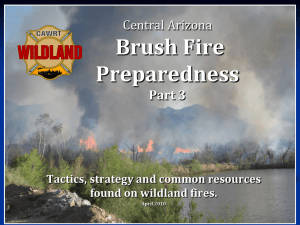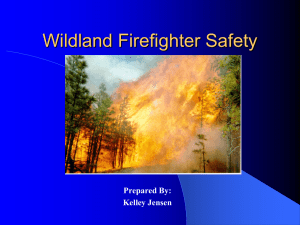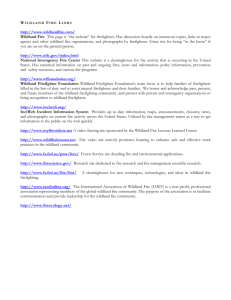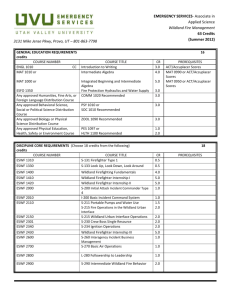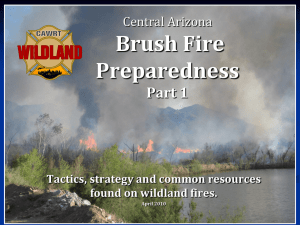Chapter 21: Wildland and Ground Fires
advertisement
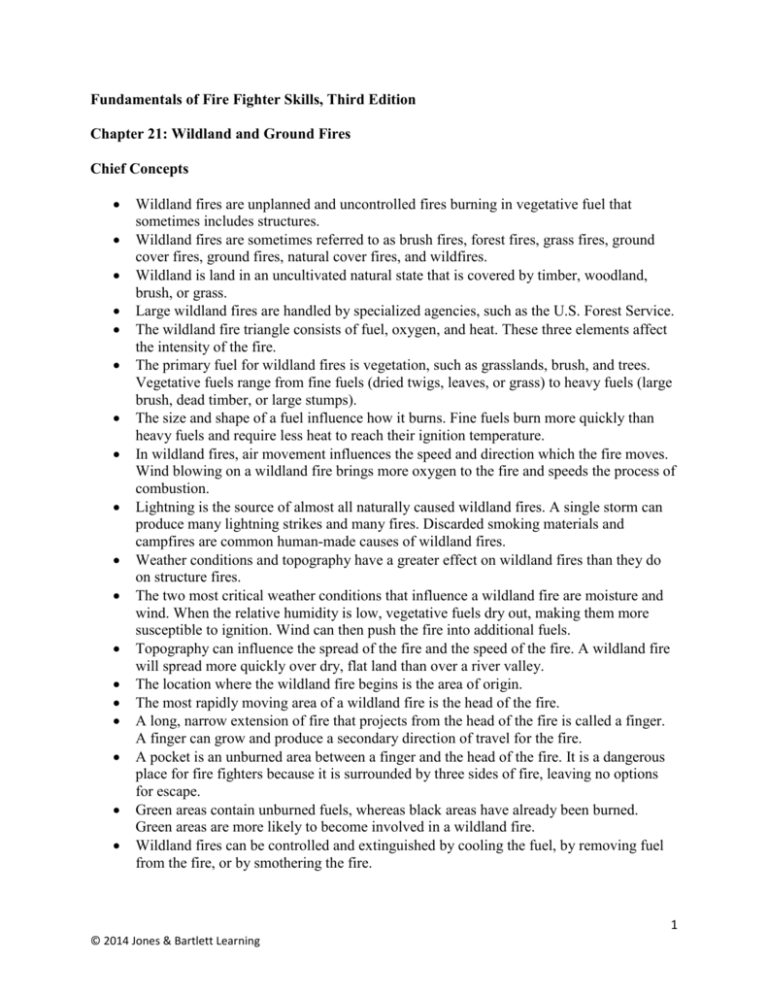
Fundamentals of Fire Fighter Skills, Third Edition Chapter 21: Wildland and Ground Fires Chief Concepts Wildland fires are unplanned and uncontrolled fires burning in vegetative fuel that sometimes includes structures. Wildland fires are sometimes referred to as brush fires, forest fires, grass fires, ground cover fires, ground fires, natural cover fires, and wildfires. Wildland is land in an uncultivated natural state that is covered by timber, woodland, brush, or grass. Large wildland fires are handled by specialized agencies, such as the U.S. Forest Service. The wildland fire triangle consists of fuel, oxygen, and heat. These three elements affect the intensity of the fire. The primary fuel for wildland fires is vegetation, such as grasslands, brush, and trees. Vegetative fuels range from fine fuels (dried twigs, leaves, or grass) to heavy fuels (large brush, dead timber, or large stumps). The size and shape of a fuel influence how it burns. Fine fuels burn more quickly than heavy fuels and require less heat to reach their ignition temperature. In wildland fires, air movement influences the speed and direction which the fire moves. Wind blowing on a wildland fire brings more oxygen to the fire and speeds the process of combustion. Lightning is the source of almost all naturally caused wildland fires. A single storm can produce many lightning strikes and many fires. Discarded smoking materials and campfires are common human-made causes of wildland fires. Weather conditions and topography have a greater effect on wildland fires than they do on structure fires. The two most critical weather conditions that influence a wildland fire are moisture and wind. When the relative humidity is low, vegetative fuels dry out, making them more susceptible to ignition. Wind can then push the fire into additional fuels. Topography can influence the spread of the fire and the speed of the fire. A wildland fire will spread more quickly over dry, flat land than over a river valley. The location where the wildland fire begins is the area of origin. The most rapidly moving area of a wildland fire is the head of the fire. A long, narrow extension of fire that projects from the head of the fire is called a finger. A finger can grow and produce a secondary direction of travel for the fire. A pocket is an unburned area between a finger and the head of the fire. It is a dangerous place for fire fighters because it is surrounded by three sides of fire, leaving no options for escape. Green areas contain unburned fuels, whereas black areas have already been burned. Green areas are more likely to become involved in a wildland fire. Wildland fires can be controlled and extinguished by cooling the fuel, by removing fuel from the fire, or by smothering the fire. 1 © 2014 Jones & Bartlett Learning Backpack pump extinguishers may be effective against small wildland fires with light fuel loads. Water may also be applied by hoses on special wildland fire trucks or by aircraft. Hand tools such as rakes and power tools such as chainsaws may be used to remove fuel from the fire. CAFS foam may be used to smother wildland fires. The two general types of attacks used to contain and extinguish wildland fires are direct attacks and indirect attacks. A direct attack is mounted by containing and extinguishing the fire at its burning edge. An indirect attack is mounted by building a fire line along natural fuel breaks, at favorable breaks in the topography, or at considerable distance from the fire and then burning out the intervening fuel. All fire fighters should ensure that they know the escape route and escape plan before attacking a wildland fire. The hazards of wildland fires include fire apparatus rollovers, falls, burns, smoke inhalation, dehydration, and heat stroke. The fire shelter is one of the most important pieces of PPE for wildland fire fighters. Fire shelters are designed to reflect 95 percent of a fire’s radiant heat for a short period of time. The wildland–urban interface is the mixing of wildland and developed areas. Because many people live in the wildland–urban interface, fires in this zone present a significant risk to both lives and structures. 2 © 2014 Jones & Bartlett Learning


